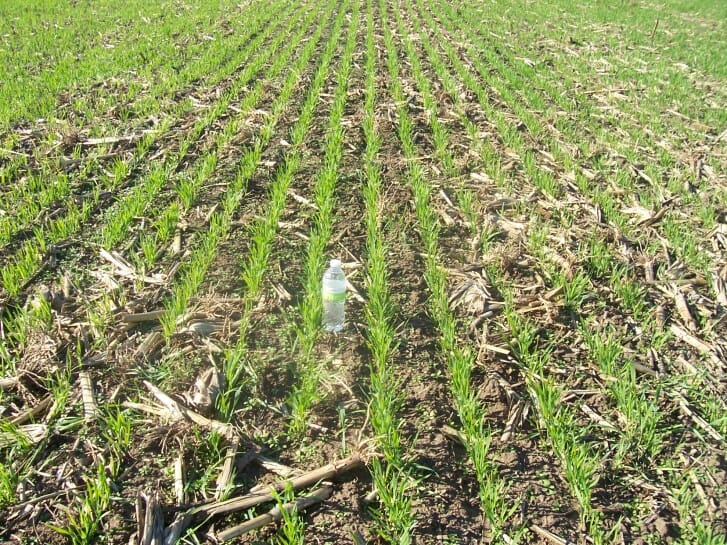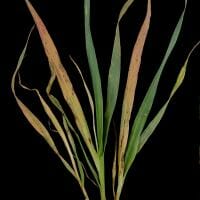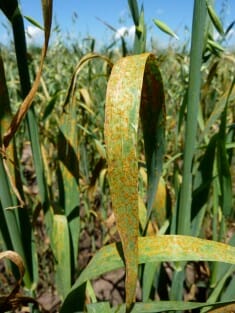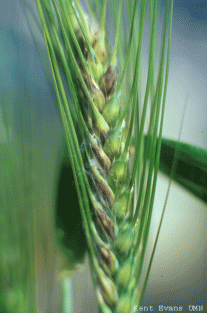Fertilizers, Herbicides and Fungicides for Small Grains
By now, small grains have been planted and farmers have turned their attention to planting corn, and later to soybeans, but farmers must remember to continue to monitor small grains development during this busy planting time in order to achieve good quality grain. The March 10 shared learning call focused on best practices for fertilizer, herbicide and fungicide application as the three main management activities for small grains in the spring. The following are tips from our presenters David Weisberger, graduate researcher at ISU studying oat agronomy, and Bruce Roskens, Director of Crop Sciences at Grain Millers.
Fertilize pre or at planting to avoid lodging.
Small grain crops do not require as much nitrogen fertilizer as their large grain cousin, corn, and applying fertilizer at the wrong time can cause more problems than it solves. For oats, applying fertilizer at or after V4 stage will tend to increase height and decrease standability – increasing the likelihood that the crop will grow too tall to support its own weight and fall over or lodge. Pay attention to the characteristics of the variety to determine if it can handle a late fertilizer application. North Dakota and South Dakota lines like Deon and Hayden tend to get very tall so they are at high risk of lodging with late fertilizer applications. But, Illinois varieties are shorter and respond better to these late applications. In general, it’s better to keep fertilizer applications to pre-planting or soon after planting. Check the standability rating on the seed variety notes to gauge the risk of lodging with a later application.

When small grains are small, like these oats or even smaller, it’s the best time to be making fertilizer and herbicide applications. Vic Madsen photographed this field on 4/22/17 (planted on 3/20/17).
With oats, you also should pay attention to your rotation and the N to P ratio. David says, “What’s the rotation? If you’re following soybeans or have applied nitrogen be very careful about post-planting nitrogen application. You will get a lot of growth, but if you don’t have enough phosphorous it will lodge. Phosphorous is responsible for root growth and shoot strength that will keep the plant from tipping over.”
For small grains besides oats, like wheat or barley, early fertilizer effects will be similar, increasing early tillering. However, with later season fertility is markedly different. Bruce advises, “If you’re trying to do a malt, you don’t want to hit too high with nitrogen on barley because you want low protein. Top dressing wheat and barley will boost protein – desirable for wheat, but not for barley destined for the maltster.” Because wheat and barley are shorter than oats they have better resistance to lodging. For a winter wheat, some farmers feel that a split application between fall and spring helps the plant overwinter and increases stand quality in the spring, you could apply up to 100 lbs nitrogen total using the split application method.
For rye, fertilizer recommendations depend on whether it’s a hybrid or an open-pollinated variety. Bruce says, “Newer hybrid ryes have uniformity and shorter stature, so you can pump the N up pretty high, but older varieties with plant height of close to 3 ft you have to be really careful with N management. For open-pollinated varieties you want to have 40-60 lbs N available for the rye crop and absolutely no higher than 80 lbs. You can go higher with hybrid rye.”
Apply herbicides pre-planting or in early growth stages and verify product with buyer.
With oats, “when they are early stage and there are only two leaves on the plant above ground, you can get away with herbicide applications without damaging the oats because the growing point is still below ground,” David says. Bruce also offers, “several herbicides should go on before V4 stage. After this the panicum primordium will start ascending and you can stunt the plant, increasing the blasting of heads that are trying to develop.”

Oats with herbicide damage typically display red/yellow burned leaves as pictured. Photo: 2015 DAFWA
Bruce also warns to double check your herbicide equipment and product selection. “If you’re doing your own spraying, make sure you don’t have any previous residue from herbicide in your equipment because oats are very sensitive to glyphosate. You’ll see lots of leaf burning.” He also recommends using amine formulations of herbicides instead of the ester formulations, which are harsher on young, grass leaves of oats, barley, and wheat.
Additionally, because food grade oats are destined for direct human consumption, they are regularly tested and face high standards for product residues. Check with your buyer on their testing limits for different active ingredients before spraying. Given these high standards, the best weed control for small grains doesn’t come from chemicals at all – it starts with a well-calibrated drill and 7 or 9 inch row spacing. Bruce says, “This will result in good even tillering so you get the ground cover to suppress early developing weeds.”
Scout often and spray fungicides at or before heading.
By far, the most pressing management challenge for small grains is managing fungal diseases. “Fungicides are not a prophylactic treatment! The disease has to be there and active for several days to work,” Bruce says. But ironically, he says, “The main problem with fungicide use is applying it too late. If the oat is heading out and you’ve already got the rust, the damage is done.” This means that there is a sweet spot from 3-4 days after the disease manifests until the seed heads emerge from the stalk to treat effectively with fungicide. The only way to catch this brief window is to scout regularly.
When oats are at 3-4 leaf stage, start scouting for early season crown rust, which will appear as a red pustule. The pustule indicates that the fungus is in a sexual stage so it will repopulate under wet conditions. After it spreads, crown rust presents as organic pustules on both oats and barley. When one of these fungal diseases is detected, check the variety trials in your state and surrounding states to see if the variety shows any advantage from fungicide treatments. For example, Shelby 427 has no significant difference in yield between fungicide and no-fungicide trials.
For wheat and barley, Bruce says, “as soon as heading occurs start scouting every 2-3 days for scab. Be as proactive as you possibly can be – note the conditions for scab.” He recommends that you use resources like http://www.wheatscab.psu.edu/ and https://scabsmart.org/ to anticipate, track, and treat this disease caused by Fusarium Head Blight or the USDA page on cereal rusts.
When selecting a fungicide, it is often beneficial to choose a mixed product that has more than one active ingredient because they can last a little longer on the plant. Another consideration Bruce offered was, “In a hotter environment, some of the compounds like Headline can be rough on the plant, you can see some burning.”
For all three types of product applications, our presenters recommended to proceed with caution and read the variety notes and trial results for guidance on application rates, dates and return on investment. With many of these products, less is more, and the timing of the application is essential to its effectiveness. For more production information about growing small grains visit our Small Grains page. Check out the other blogs in our shared learning call series on variety selection, grain markets and straw markets for more information on successfully integrating small grains into a farm business. The next shared learning call will be held on Friday, June 2 at noon, email alisha@practicalfarmers.org if you are interested in joining.


